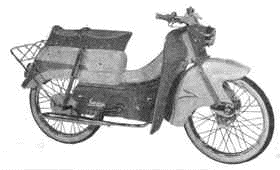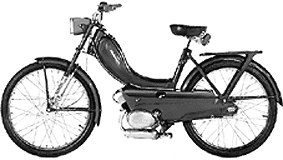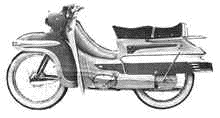|
Belgium, 1958 - At the Brussels World Exhibition tourists are taken from one pavilion to another by three-wheeled Superia moped cabs powered by German Sachs engines.
Back in the fifties Belgian roads were not nearly as crowded as today. Very few cars were around in these post-war years, and bicycles were about the only means of individual transportation. French made Solex and Mobylette were among the first mopeds introduced. They were reasonably priced and very successful... No wonder that local bicycle manufacturers wanted their piece of the cake and tried to get their own mopeds on the market as soon as possible.
Since the new moped was equipped with a hand operated clutch, it started off without pedalling, a rare feat at the time! Unfortunately the brothers did not get along too well, so they decided to separate and to become each-other's competitor, the upshot being that they divided their plant in two (literally, by means of a brick wall...). Aimé kept the Claeys engine and the Flandria marque, whereas Remi created a new brand: Superia. Having obtained the frame division, he started right away with the production of Superia mopeds equipped with German Sachs engines.
Mopeds lost their status and became purely utilitarian vehicles as reflected by their downright simplistic design (the1967 Futura is a good example of this tendency)
Youngsters had more money as well. They dreamt of "the real thing", a genuine motorcycle... Unfortunately one had to be eighteen for that and one had to wear that dreadful helmet!
This created a most welcome niche for Flandria who from now
on would be most successful with a new line of fast "sports"
mopeds, i.e. small motorbike look-alikes which could be ridden
as from the age of 16... and no need for a helmet. But all too soon, new laws came into force. Mopeds could not go faster than 40 kmh (25 mph) and helmets became compulsory. Sales dropped dramatically, and collapsed even more with the advent of Japanese competition. Even time-honoured German marques such as NSU, Zündapp and Kreidler ceased to exist. The curtain falls in 1981. Flandria moped production is definitively discontinued as the company goes bankrupt. Once so popular Flandria mopeds will soon disappear from the streets... |
 Major
competitor Flandria is absent from this big international event:
they are working very hard to get their powerful new three speed
engine ready for launch in 1959.
Major
competitor Flandria is absent from this big international event:
they are working very hard to get their powerful new three speed
engine ready for launch in 1959. The
Claeys brothers, owners of the Flandria bicycle manufacturing
company, thought along the same lines and soon came up with a
state of the art moped for two, powered by their own Claeys
49 cc two speed engine (Incidentally: Flandria is Latin for
Flanders, the northern, Dutch speaking part of Belgium, where
the factory was located).
The
Claeys brothers, owners of the Flandria bicycle manufacturing
company, thought along the same lines and soon came up with a
state of the art moped for two, powered by their own Claeys
49 cc two speed engine (Incidentally: Flandria is Latin for
Flanders, the northern, Dutch speaking part of Belgium, where
the factory was located).  A
totally new Flandria Majestic was introduced in 1958. Its
overall look, its two tone finish and other details were most
reminiscent of the magnificent U.S. cars of the era, and this
was hardly a coincidence... (it is whispered that clever Aimé
wanted to make his buyers live under the impression that riding
a moped of such luscious design would give them equal status with
the wealthy owners of the superb dream cars of those days of yore...).
A
totally new Flandria Majestic was introduced in 1958. Its
overall look, its two tone finish and other details were most
reminiscent of the magnificent U.S. cars of the era, and this
was hardly a coincidence... (it is whispered that clever Aimé
wanted to make his buyers live under the impression that riding
a moped of such luscious design would give them equal status with
the wealthy owners of the superb dream cars of those days of yore...).
 The
60's were characterized by economic growth and more prosperity
for all. People were finally able to buy small cars.
The
60's were characterized by economic growth and more prosperity
for all. People were finally able to buy small cars. 
